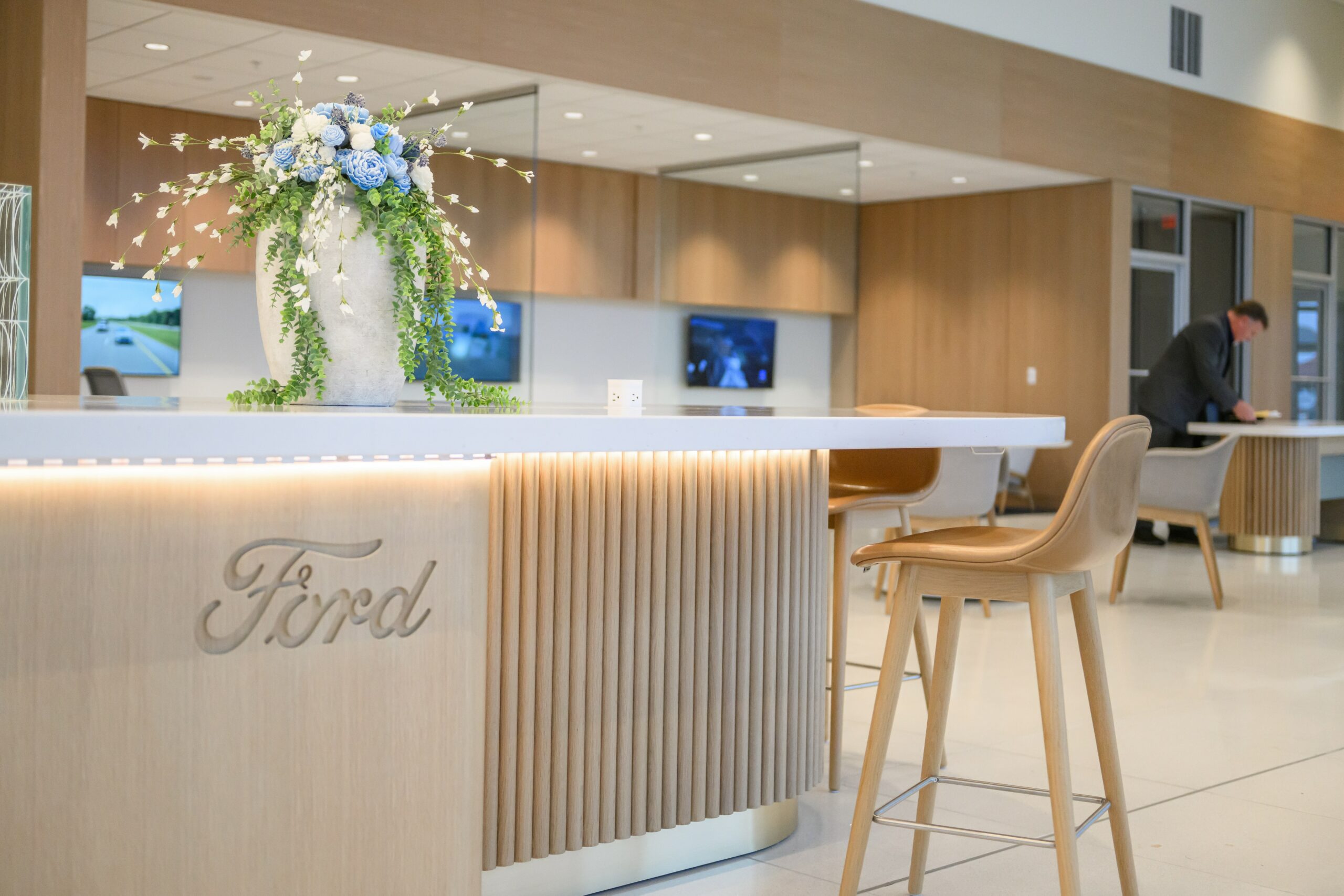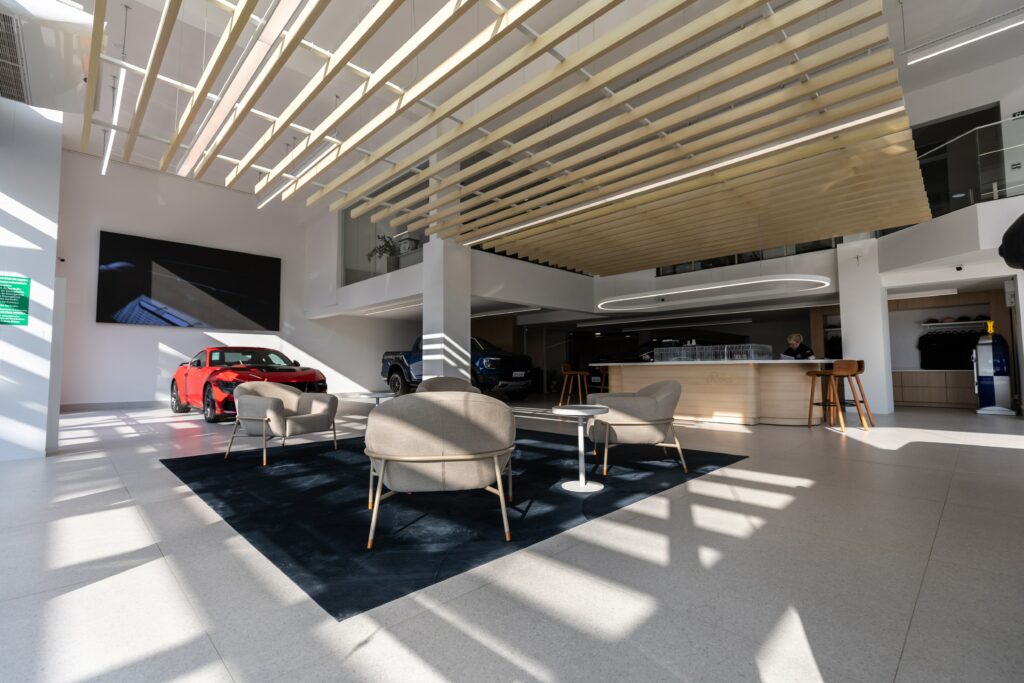
Photo courtesy of Ford
November 7, 2025
Will Ford’s New Retail Experience Deliver Results?
In a move meant to reshape its brand experience in dealerships worldwide, Ford recently released news that it was kicking off an expansive plan — titled Ford Signature 2.0 — to update and modernize the way would-be Ford owners engage with sales staff on premises.
“The design delivers on Ford’s global brand strategy by offering ways for customers to explore Ford’s exciting products while building trust and community with the dealership,” the Ford release noted.
“To support dealership associates in delivering on this promise, Ford also provides guest experience training for dealership staff globally, focusing on service, communications, and anticipating customer needs,” it added.
The Ford Signature 2.0 experience rests upon four primary pillars, as follows:
- Discover Ford: This cornerstone hints at an array of immersive brand experiences — likely digital in-house marketing and information packages — which aim at informing customers about Ford’s accessories, core products, and technological edges in visual and tactile senses.
- Hospitality first: A zeroing in on dealership staff as brand ambassadors, this pillar promises dedicated hospitality spaces where car shoppers can chat with staff with questions, concerns, or other topics. Both food and beverages will be provided in these areas, whether showroom or service spaces.
- Operations excellence: Ford was rather ambiguous on this front, simply speaking to efficient design to “optimize flow and functionality,” with an emphasis on “employee spaces” closing out the explanation.
- Sales and service anywhere: Providing the option for car buyers to either conduct business in a traditional sales space or in a hospitality area was underscored as a highlight of this expansion in the retail experience.

Finally, Ford emphasized the importance of blending its new digital and in-person sales funnel. In the U.S. in addition to 15 European markets, prospective buyers are able to initiate their build, price out, and customization of said build online or in-person, being able to bring any process — at any point in the customer journey — to the dealership to close the transaction.
Ford’s US Sales Appear Strong, Despite EV Business Faltering, and Trucks Are its Moneymaker
According to the Detroit Free Press, Ford has enjoyed a bit of a rebound when it comes to its fortunes stateside, selling 175,584 vehicles in the U.S. in October — a slight 1.6% uptick versus last year’s figures in the same time frame. Concerning YTD through the end of October, Ford sold a little more than 1.8 million vehicles in the United States (1,834,492), a statistic which represents a 6.6% improvement over 2024’s numbers.
However, in October Ford also observed a drastic decline — perhaps expected, due to the expiry of the $7,500 federal EV tax credit — in EV sales, a 25% decline resulting in 4,709 total EVs sold. However, YTD through October Ford has seen a marginal improvement in its EV sales, up 0.5% versus last year’s sales.
On the other hand, much of Ford’s recent strength can be laid at the feed of healthy sales tied to its gasoline-powered trucks and other larger vehicles. Of all vehicles sold in October, the majority (1,052,573) were classified as gas-powered pickup trucks.
“The money-making machines continue to sell well,” Cox Automotive spokesman Mark Schirmer told the Detroit Free Press. “F-Series volume at 67,000 was slightly above the five-year average. Bronco, Bronco Sport, the commercial vans — all healthy volume. The big vehicles continue to move and that’s good for Ford’s bottom line. “
Discussion Questions
Will Ford’s investment in revamping its retail experience in dealership showrooms lead to a notable increase in sales? Why or why not, in your opinion?
From a broader perspective, how important is/are the aesthetic, comfort level, and marketing installations from a consumer perspective, when visiting a dealership?
Is Ford correct to allocate its funds in this direction, or are there other areas of concern which could benefit more from this spending?
Poll
BrainTrust
Nicholas Morine
Recent Discussions








I like the hospitality. I like the more omnichannel approach connecting online and stores. I like the smart design. Hopefully these things also help to smooth the process and get rid of some of the ‘hard sell’ elements of buying a new car from a dealer. Good, trustworthy customer service with low to no pressure selling is the real winning ingredient.
What’s not to like? It’s still a Ford and not an Audi but the idea of providing a branded experience is similar. Execution is the key.
Then again, an F150 lists for about $50K these days, comparable with an A4.
Maybe Ford has figured out that its buyers can afford to go elsewhere….
I like what Ford is doing. It’s always exciting to introduce something new, but much of what is new is just keeping up (for any company/brand, not just Ford). Regarding hospitality, this is about the customer experience. Any automotive brand must deliver a level of service that attracts and keeps customers – or they won’t be able to compete with those that do. Furthermore, all the aesthetics, comfort level, marketing installations, etc., won’t mean anything unless the experience is delivered at the local dealer level.
A friend of mine was once tasked with increasing sales at a department store chain’s auto centers. Auto center staff told him that female customers hated dingy and dirty waiting rooms with no magazines and no coffee. Upgrading the Ford experience will definitely pay off.
I wish Ford success. It will be far harder to have these changes make a difference than only announcing a clever program. It’s also not clear to me that, as implied, configuring what I want at home will make any difference in what I end up buying as that still depends on inventory availability. The digital “configure your car” services from ALL makers fail in this way. I enjoy imagining what the car “could be” but don’t find it transitions into the dealership. Further, they face a difficult staffing challenge. I once spent a few hours visiting with a trainer for another massive automaker. They described endless challenges between knowing how dealer sales could be improved and the tendency of sales managers and their sales teams to still ask customers “what can I do to get you to walk out of here today with this car?” The answer in 999 out of 1000 instances is — nothing. He told me that single question was their most massive problem. I’ll observe the talent pool and management styles for that talent pool make it unlikely it will ever change — despite the reality we know that “Always Be Closing” reduces rather than increases closed deals.
Love the hospitality concept for the Ford brand. Being able to ask questions and not feel like you’re being pulled toward the sales managers office will go a long way for customers exploring, getting comfortable. If it leads customers to taking the next step, hopefully they have multiple buying paths to choose from, new or traditional.
Across every car brand – there is too often a dramatic difference between customer care before the car purchase and after-sales. The most dramatic illustration of that I have ever seen was in a Ford franchise dealer in the UK some years ago – where the new-car sales chairs were wide and padded yet the service waiting chars were hard plastic – similar to what you may see in your local school classrooms.
Dealers have done what they can to retain drivers for the post-sale service over time but this continually fails – often the only thing that keeps a driver servicing with the franchisee are the conditions of the warranty or finance agreement.
This will be a fascinating area to watch as ICE cars get older and the lower maintenance requirements of BEVs become more prevalent.
Ford is being proactive in bringing retail concepts into the car purchase journey. A customer-centric experience is essential for fostering long-term brand loyalty and navigating a digital-first future. Ford products must continue to innovate and deliver on quality and value to make the experience effective.
While Ford’s Signature 2.0 plan is visually appealing, we have to ask if this is truly a “new retail experience” or just a glossy new cover on an old book. Labeling “Hospitality first” as a central pillar feels like branding a fundamental requirement, not a revolution. Customer service, staff training, and a comfortable environment are table stakes when selling a high-value product like a vehicle. If the core sales culture remains high-pressure, no amount of free coffee or digital screens will build lasting trust. The true test of this update lies not in the “Discover Ford” aesthetics, but in the ethical overhaul of sales incentives and staff behavior. Without that fundamental change, Ford risks spending a fortune on a refresh that fails to address the deep-rooted trust deficit common in dealerships.